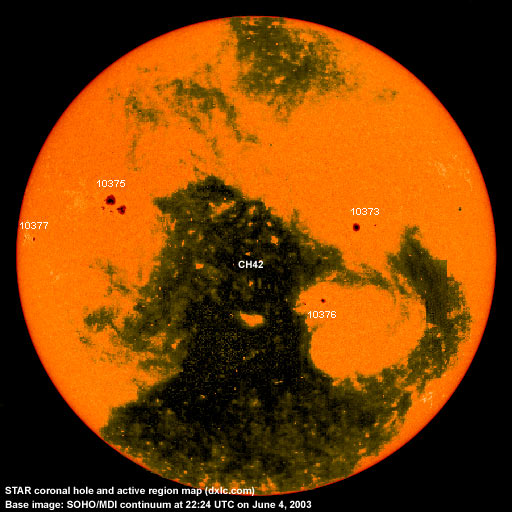

Last update issued on June 5, 2003 at 02:55 UTC.
[Solar and geomagnetic data - last month (updated daily)]
[Solar wind and electron fluence charts (updated daily)]
[Solar cycles 21-23 (last update June 3, 2003)]
[Solar cycles 1-20]
[Graphical comparison of cycles 21, 22 and 23 (last update June 3, 2003)]
[Graphical comparison of cycles 2, 10, 13, 17, 20 and 23 (last update June 3, 2003)]
[Historical solar and geomagnetic data charts 1954-2003 (last update April 13, 2003)]
[Archived reports (last update June 1, 2003)]
The geomagnetic field was unsettled to active on June 4. Solar wind speed ranged between 668 and 854 km/sec under the influence of a high speed stream from coronal hole CH42.
Solar flux measured at 20h UTC on 2.8 GHz was 105.6. The planetary A
index was 21 (STAR Ap - based on the mean of three hour interval ap indices: 22.3).
Three hour interval K indices: 43344443 (planetary), 43344333 (Boulder).
The background x-ray flux is at the class B3 level.
At midnight there were 4 spotted regions on the visible disk. Solar flare activity was low. A single C class event was recorded during the day.
Region 10373 decayed slowly and quietly and appear to be losing its leader spot.
Region 10375 was mostly quiet and developed slowly with most of the development occurring in the southern part. Flare:
C1.8 long duration event peaking at 05:45 UTC.
Region 10376 decayed slowly and quietly.
New region 10377 emerged at the northeast limb.
June 2-4: No obviously geoeffective CMEs observed.
Coronal hole history (since late October 2002)
Compare today's report with the situation one solar rotation ago: 28
days ago 27 days ago 26
days ago
A huge recurrent coronal hole (CH42) in the southern hemisphere will rotate into a geoeffective position on May 29-June 6.

Processed SOHO EIT 284 image at 01:06 UTC on June 5. Any black areas on the solar disk are likely coronal holes.
The geomagnetic field is expected to be unsettled to minor storm until June 9 due to a high speed stream from coronal hole CH42.
Long distance medium wave (AM) band propagation along east-west paths over high and upper middle latitudes is very poor and will likely remain very poor until at least June 10. Propagation along north-south paths is fair. [Trans Atlantic propagation conditions are currently monitored every night on 1470 kHz. Dominant stations tonight: Radio Cristal del Uruguay and Cadena Peruana de Noticias.]
| Coronal holes (1) | Coronal mass ejections (2) | M and X class flares (3) |
1) Effects from a coronal hole could reach Earth within the next 5 days.
2) Material from a CME is likely to impact Earth within 96 hours.
3) There is a possibility of either M or X class flares within the next 48 hours.
Green: 0-20% probability, Yellow: 20-60% probability, Red: 60-100% probability.

Compare to the previous day's image.
Data for all numbered solar regions according to the Solar Region Summary provided by NOAA/SEC. Comments are my own, as is the STAR spot count (spots observed at or inside a few hours before midnight) and data for regions not numbered by SEC or where SEC has observed no spots.
| Solar region | Date numbered | SEC spot count |
STAR spot count |
Location at midnight | Area | Classification | Comment |
|---|---|---|---|---|---|---|---|
| 10368 | 2003.05.22 | S32W89 | plage | ||||
| 10373 | 2003.05.27 | 5 | 3 | N07W28 | 0130 | DAO |
classification was CSO at midnight |
| 10375 | 2003.06.01 | 19 | 22 | N11E39 | 0370 | EAI | |
| 10376 | 2003.06.02 | 7 | 4 | S11W14 | 0070 | DSO | |
| 10377 | 2003.06.04 | 3 | 3 | N04E71 | 0030 | CSO | |
| S171 | emerged on 2003.05.28 |
S23W89 | plage | ||||
| S172 | emerged on 2003.05.28 |
S17W70 | plage | ||||
| S173 | emerged on 2003.05.28 |
N05W47 | plage | ||||
| S174 | emerged on 2003.05.30 |
N18W66 | plage | ||||
| S175 | emerged on 2003.05.31 |
N14W37 | plage | ||||
| Total spot count: | 34 | 32 | |||||
| SSN: | 74 | 72 | |||||
| Month | Average solar flux at Earth |
International sunspot number | Smoothed sunspot number |
|---|---|---|---|
| 2000.04 | 184.2 | 125.5 | 120.8 cycle 23 sunspot max. |
| 2000.07 | 202.3 | 170.1 | 119.8 |
| 2001.12 | 235.1 | 132.2 | 114.6 (-0.9) |
| 2002.05 | 178.4 | 120.8 | 108.8 (-1.7) |
| 2002.06 | 148.7 | 88.3 | 106.2 (-2.6) |
| 2002.07 | 173.5 | 99.6 | 102.7 (-3.5) |
| 2002.08 | 183.6 | 116.4 | 98.7 (-4.0) |
| 2002.09 | 175.8 | 109.6 | 94.6 (-4.1) |
| 2002.10 | 167.0 | 97.5 | 90.5 (-4.1) |
| 2002.11 | 168.7 | 95.5 | 85.2 (-5.3) |
| 2002.12 | 157.2 | 80.8 | (81.4 predicted, -3.8) |
| 2003.01 | 144.0 | 79.5 | (78.3 predicted, -3.1) |
| 2003.02 | 124.5 | 46.2 | (73.3 predicted, -5.0) |
| 2003.03 | 131.4 | 61.5 | (67.6 predicted, -5.7) |
| 2003.04 | 126.4 | 60.0 | (62.7 predicted, -4.9) |
| 2003.05 | 115.7 | 55.2 | (57.8 predicted, -4.9) |
| 2003.06 | 113.5 (1) | 8.5 (2) | (53.8 predicted, -4.0) |
1) Running average based on the daily 20:00 UTC observed solar flux value at 2800 MHz.
2) Unofficial, accumulated value based on the Boulder (NOAA/SEC) sunspot number. The official international sunspot number is typically
30-50% less.
This report has been prepared by Jan Alvestad. It is based partly on my own observations and interpretations, and partly on data from sources noted in solar links. All time references are to the UTC day. Comments and suggestions are always welcome.
| [DX-Listeners' Club] |